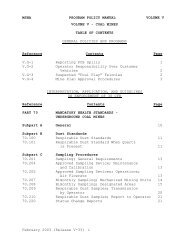MSHA HANDBOOK SERIES - PH13-V-1 - Mine Safety and Health ...
MSHA HANDBOOK SERIES - PH13-V-1 - Mine Safety and Health ...
MSHA HANDBOOK SERIES - PH13-V-1 - Mine Safety and Health ...
You also want an ePaper? Increase the reach of your titles
YUMPU automatically turns print PDFs into web optimized ePapers that Google loves.
GENERAL COAL MINE INSPECTION PROCEDURES AND<br />
INSPECTION TRACKING SYSTEM <strong>HANDBOOK</strong> CHAPTER 5<br />
report. If the analysis of an air sample discloses a violation not determined with<br />
testing instruments during the inspection, the inspector shall issue the appropriate<br />
enforcement action.<br />
B. Air Measurements.<br />
Anemometer - Use a properly calibrated anemometer to measure the velocity when<br />
calculating the volume of air for compliance with the Act <strong>and</strong> for calculating the<br />
liberation of methane in, but not limited to, a return aircourse. When determining air<br />
velocities, take a traverse reading of the cross section that is measured. Use correction<br />
factors for the individual anemometers to determine the actual air velocity.<br />
When measuring air velocities less than 100 feet-per-minute, the use of chemical<br />
smoke may be necessary. However, if the instrument is calibrated for a lower<br />
velocity, it is acceptable.<br />
Pitot Tube - The pitot tube is a primary st<strong>and</strong>ard instrument for determining<br />
velocities of 750 to 10,000 fpm. Velocities in excess of 2,000 fpm may crack the<br />
bearings of ordinary vane anemometers <strong>and</strong> thus prohibit their use in high velocities.<br />
High airflow velocity measurements are often required in auxiliary fan tubing or<br />
main fan ducts. For such measurements the pitot tube is often the most practical<br />
instrument. Commercial-type pitot tubes generally are accurate to within 1.0 percent<br />
<strong>and</strong> specially made types can be accurate to within .01 percent.<br />
Use the pitot tube in conjunction with a differential pressure gauge, such as a<br />
manometer or water gauge, to determine the velocity pressure of the airflow. The<br />
pressure gauge most commonly used by <strong>MSHA</strong> is the “Magnehelic”, which provides<br />
a reading in inches of water (in. wg.). Using the inches of water reading, determine<br />
the velocity <strong>and</strong> air quantity by calculation or by using conversion tables. Further<br />
information about the techniques for using anemometers/chemical smoke <strong>and</strong> pitot<br />
tubes is available in the 1960 Bureau of <strong>Mine</strong>s Bulletin 589, “Introduction to <strong>Mine</strong><br />
Ventilation Principles <strong>and</strong> Practices.”<br />
To convert inches of water to velocity, use the following formula:<br />
V = 4005 √VP<br />
Where V = velocity in feet-per-minute (fpm)<br />
VP = velocity pressure in inches of water (in wg.)<br />
NOTE: To correct centerline measurements, multiply velocity (V) by a method factor<br />
of 0.9. The true velocity is then multiplied by area (A) to obtain air quantity (Q).<br />
Release 1 (February 2013) 5-3
















